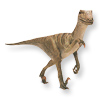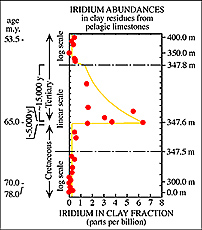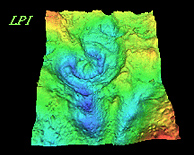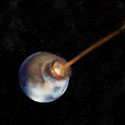EXTINCTION ll
 |
|
SECTIONS |
| GENERAL
FACTS CLASSIFICATION ANATOMY NEWS and ARTICLES DINOSAUR PICTURES GLOSSARY ADVANCED TOPICS EXTINCTION THEORIES I ASTERIOD IMPACT EXHIBITS FUN and ACTIVITIES DISCUSSION GROUPS CHAT ROOMS |
 |
|
Castrophes from
Space - Asteriod Impact Theory |
| THE ALVAREZ ASTEROID IMPACT
THEORY There are a lot of theories about why this K-T (Cretaceous-Tertiary) extinction occurred, but a widely accepted theory (proposed in 1980 by physicist Luis Alvarez and his son Walter Alvarez, a geologist), is that an asteroid 4-9 miles (6-15 km) in diameter hit the Earth about 65 million years ago.  The impact would have penetrated the Earth's
crust, scattering dust and debris into the atmosphere, and causing
huge fires (generated by hot debris thrown from the crater),
tsunamis, severe storms with high windsand highly acidic rain ,
seismic activity, and perhaps even volcanic activity . This dust and
debris is shown in the picture to the right. The impact would have penetrated the Earth's
crust, scattering dust and debris into the atmosphere, and causing
huge fires (generated by hot debris thrown from the crater),
tsunamis, severe storms with high windsand highly acidic rain ,
seismic activity, and perhaps even volcanic activity . This dust and
debris is shown in the picture to the right. The impact could have caused chemical changes in the Earth's atmosphere, increasing concentrations of sulfuric acid, nitric acid, and fluoride compounds. The heat from the impact's blast wave would have incinerated all the life forms in its path. The dust and debris thrust into the atmosphere would have blocked most of the sunlight for months, and lowered the temperature globally. |
| Those organisms that could not adapt to the temperature and
light changes would die out. Since plants' energy is derived from
the sun, they would likely be the first to be affected by changes in
climate. Many families of phytoplankton and plants would die out,
and the Earth's oxygen levels may well have dramatically decreased,
both on land and in the oceans, suffocating those organisms which
were unable to cope with the lower oxygen levels. Major changes in the food chain would result from all of these these environmental upheavals. The herbivores (plant eaters) who ate those plants would starve soon after the plants died. Then, at the top of the food chain, the carnivores (meat eaters), having lost their prey, would have to eat each other, and eventually die out. Their large carcasses must have provided smaller animals with food for quite a while. |
 Graph Showing Spike in Iridium Levels |
 Chicxulub crater, Yucatan Peninsula. |
IMPACT SITE FOUND? The impact structure, discovered buried beneath the shore of the Yucatan Peninsula (Chicxulub), turns out to be from 150 - 300 km in diameter, possibly the largest impact known in the world and said by some to be the largest known in the solar system. At the present diverse lines of evidence have largely confirmed the asteroid impact theory of mass extinctions and identified Chicxulub as the "smoking gun". Debate still rages by paleontologists about whether the impact was directly the cause of the extinction itself, or merely the coup de grace. |
